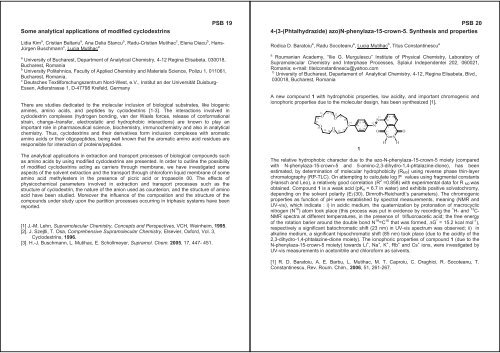ISMSC 2007 - Università degli Studi di Pavia
ISMSC 2007 - Università degli Studi di Pavia
ISMSC 2007 - Università degli Studi di Pavia
You also want an ePaper? Increase the reach of your titles
YUMPU automatically turns print PDFs into web optimized ePapers that Google loves.
Some analytical applications of mo<strong>di</strong>fied cyclodextrins<br />
PSB 19<br />
Li<strong>di</strong>a Kim a , Cristian Baltariu a , Ana Delia Stancu a , Radu-Cristian Mutihac c , Elena Diacu b , Hans-<br />
Jürgen Buschmann c , Lucia Mutihac a<br />
a<br />
University of Bucharest, Department of Analytical Chemistry, 4-12 Regina Elisabeta, 030018,<br />
Bucharest, Romania<br />
b<br />
University Politehnica, Faculty of Applied Chemistry and Materials Science, Polizu 1, 011061,<br />
Bucharest, Romania,<br />
c<br />
Deutsches Textilforschungszentrum Nord-West, e.V., Institut an der Universität Duisburg-<br />
Essen, Adlerstrasse 1, D-47798 Krefeld, Germany<br />
There are stu<strong>di</strong>es de<strong>di</strong>cated to the molecular inclusion of biological substrates, like biogenic<br />
amines, amino acids, and peptides by cyclodextrins [1-3]. The interactions involved in<br />
cyclodextrin complexes (hydrogen bon<strong>di</strong>ng, van der Waals forces, release of conformational<br />
strain, change–transfer, electrostatic and hydrophobic interactions) are known to play an<br />
important role in pharmaceutical science, biochemistry, immunochemistry and also in analytical<br />
chemistry. Thus, cyclodextrins and their derivatives form inclusion complexes with aromatic<br />
amino acids or their oligopeptides, being well known that the aromatic amino acid residues are<br />
responsible for interaction of proteins/peptides.<br />
The analytical applications in extraction and transport processes of biological compounds such<br />
as amino acids by using mo<strong>di</strong>fied cyclodextrins are presented. In order to outline the possibility<br />
of mo<strong>di</strong>fied cyclodextrins acting as carriers through membrane, we have investigated some<br />
aspects of the solvent extraction and the transport through chloroform liquid membrane of some<br />
amino acid methylesters in the presence of picric acid or tropaeolin 00. The effects of<br />
physicochemical parameters involved in extraction and transport processes such as the<br />
structure of cyclodextrin, the nature of the anion used as counterion, and the structure of amino<br />
acid have been stu<strong>di</strong>ed. Moreover the influence of the composition and the structure of the<br />
compounds under study upon the partition processes occurring in triphasic systems have been<br />
reported.<br />
[1] J.-M. Lehn, Supramolecular Chemistry, Concepts and Perspectives, VCH, Weinheim, 1995.<br />
[2]. J. Szejtli, T. Osa, Comprehensive Supramolecular Chemistry, Elsevier, Oxford, Vol. 3,<br />
Cyclodextrins, 1996.<br />
[3]. H.-J. Buschmann, L. Mutihac, E. Schollmeyer, Supramol. Chem. 2005, 17, 447- 451.<br />
PSB 20<br />
4-(3-(Phtalhydrazide) azo)N-phenylaza-15-crown-5. Synthesis and properties<br />
Ro<strong>di</strong>ca D. Baratoiu a , Radu Socoteanu a , Lucia Mutihac b , Titus Constantinescu a<br />
a<br />
Roumanian Academy, “Ilie G. Murgulescu” Institute of Physical Chemistry, Laboratory of<br />
Supramolecular Chemistry and Interphase Processes, Splaiul Independentei 202, 060021,<br />
Romania; e-mail: titelconstantinescu@yahoo.com<br />
b<br />
University of Bucharest, Departament of Analytical Chemistry, 4-12, Regina Elisabeta, Blvd.,<br />
030018, Bucharest, Romania<br />
A new compound 1 with hydrophobic properties, low aci<strong>di</strong>ty, and important chromogenic and<br />
ionophoric properties due to the molecular design, has been synthesized [1].<br />
25 24 23 22<br />
O<br />
21<br />
26 O 20<br />
27<br />
19<br />
O<br />
N<br />
28 O 29<br />
30 31 32 33<br />
15 14<br />
16 13<br />
17 18<br />
1<br />
12<br />
11<br />
9<br />
10<br />
N<br />
7<br />
N<br />
5 4<br />
O 6 3 O<br />
1<br />
N<br />
2<br />
N<br />
H H<br />
The relative hydrophobic character due to the azo-N-phenylaza-15-crown-5 moiety (compared<br />
with N-phenylaza-15-crown-5 and 5-amino-2,3-<strong>di</strong>hydro-1,4-phtalazine-<strong>di</strong>one), has been<br />
estimated, by determination of molecular hydrophobicity (RM0) using reverse phase thin-layer<br />
chromatography (RP-TLC). On attempting to calculate log P values using fragmental constants<br />
(Hansch and Leo), a relatively good correlation (R 2 =0.858) with experimental data for R M0 was<br />
obtained. Compound 1 is a weak acid (pKa = 6.7 in water) and exhibits positive solvatochromy,<br />
depen<strong>di</strong>ng on the solvent polarity (ET(30), Dimroth-Reichardt’s parameters). The chromogenic<br />
properties as function of pH were established by spectral measurements, meaning (NMR and<br />
UV-vis), which in<strong>di</strong>cate : i) in aci<strong>di</strong>c me<strong>di</strong>um, the quaternization by protonation of macrocyclic<br />
nitrogen (N 19 ) atom took place (this process was put in evidence by recor<strong>di</strong>ng the 1 H- and 13 C-<br />
NMR spectra at <strong>di</strong>fferent temperatures, in the presence of trifluoroacetic acid; the free energy<br />
of the rotation barier around the double bond N 19 =C 16 that was formed, G * = 15.2 kcal mol -1 ),<br />
respectively a significant batochromatic shift (23 nm) in UV-vis spectrum was observed; ii) in<br />
alkaline me<strong>di</strong>um, a significant hipsochromatic shift (85 nm) took place (due to the aci<strong>di</strong>ty of the<br />
2,3-<strong>di</strong>hydro-1,4-phtalazine-<strong>di</strong>one moiety). The ionophoric properties of compound 1 (due to the<br />
N-phenylaza-15-crown-5 moiety) towards Li + , Na + , K + , Rb + and Cs + ions, were investigated by<br />
UV-vis measurements in acetonitrile and chloroform as solvents.<br />
[1] R. D. Baratoiu, A. E. Barbu, L. Mutihac, M. T. Caproiu, C. Draghici, R. Socoteanu, T.<br />
Constantinescu, Rev. Roum. Chim., 2006, 51, 261-267.<br />
8

















